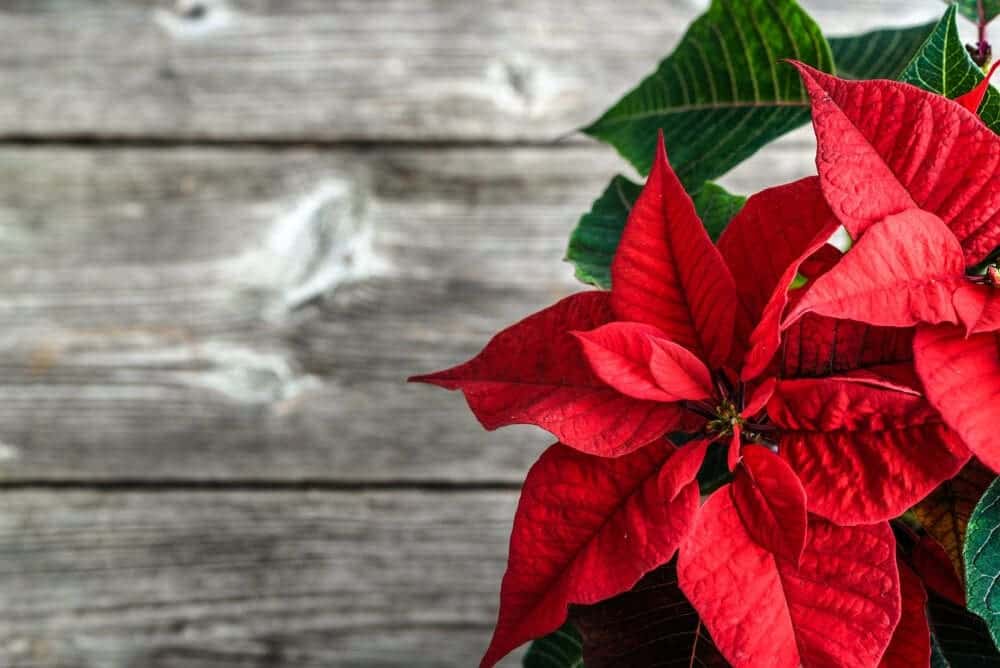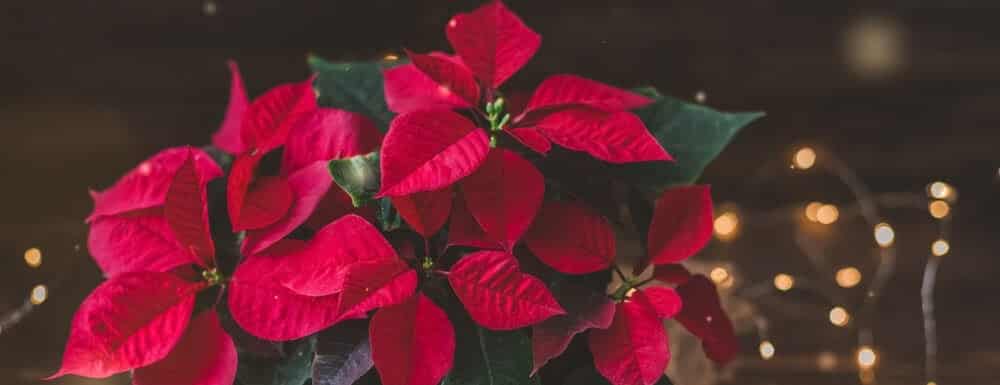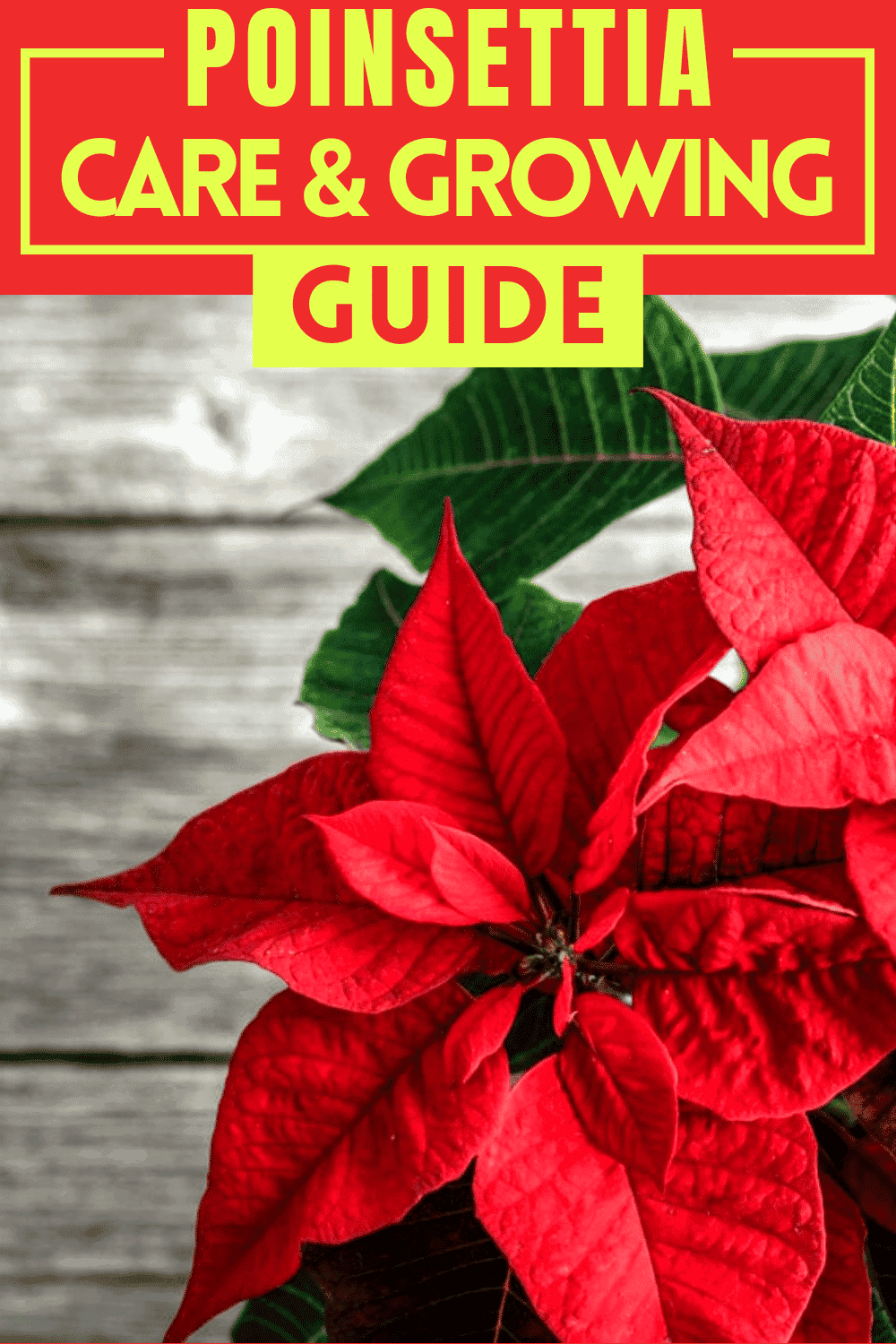You’ll know the Poinsettia the moment you see it. It is a very popular flower to decorate homes and give as presents around Christmas.
It has bright red flowers all over it, and they grow well in most warm zones and indoors.
Poinsettia Care & Growing Guide
1. Light Requirement
This plant needs a high amount of sun in order to have the energy to create its beautiful flowers. A native of Central America, it needs to be by a large window that gets several hours of indirect sun. If it receives less that it needs, it won’t bloom, and the plant will grow leggy. If it’s outside, expose it to several hours of morning light, but by noon, it should be under indirect light.
2. Water
The Poinsettia has no set schedule for watering. Simply water the soil when you see it is dry, or the leaves are beginning to curl. Every time you water it, make sure the soil is soaked and the water seeps out from the bottom drainage hole. In warmer weather, you might have to water the Poinsettia every day. Never allow the soil to be completely dry, as this can affect the roots and stop them from absorbing nutrients from the soil.
When does spring begin to roll in, you must decrease watering until the heat arrives. Then increase watering until winter arrives.
3. Climate and Temperature
If you want to keep your poinsettia blooming, then it should be in temperatures around 65 to 75 degrees. It does not like large temperature drops. If it experiences drops, the leaves will wither, and the flowers will fall off. Since it is from Central America, it likes the air to be humid. So, the plant must be misted every day with a spray bottle or placed near a humidifier. The hardiness zones it does best is 10 to 12.
4. Soil
The right type of soil for a poinsettia is one that drains very well and has a bit of peat moss in it. Adding humus to the soil will also improve the bloom. The pH of the soil should be from 5.5 to 6.5. Never allow water to sit inside the poinsettia’s container.
5. Repotting
If the Poinsettia has outgrown its current container, then it needs to be repotted. Repotting must occur before winter turns into spring. About six weeks before the first day of spring, transfer it into a pot that is two times bigger than its current container. Use soil that is fresh and contains peat and a bit of hummus to provide extra nutrients. These extra nutrients will prevent repotting shock.

6. Speed of Growth
The Poinsettia is known to be a fast-growing flowering plant. Even when it reaches maturity, it still grows quickly. In a few years, it can easily reach eight to ten feet tall.
7. Height and Spread
North Americans know the Poinsettia as a small Christmas plant that is less than a foot in size. This perception is because of the constant trimming done by gardeners to keep them that way. The Poinsettia can grow up to 10ft tall, or as tall as a small tree. Many places use them as decorations and allow them to grow 8 ft. Its spread is about half of their height, so if you have a plant that’s three feet tall, it will be 1 and 1/2 feet in width.
8. Trimming
Poinsettia has a fast growth rate. Gardeners who take care of these plants must constantly trim them to keep them at a certain size. When you trim poinsettias, make sure to wear gloves as the sap could cause irritation on your skin.
When you see yellow leaves around the bottom of the poinsettia, remove them because they are unneeded leaves.
During the late winter, remove old stems or leaves that do not receiving any sunlight
Is the Poinsettia Plant Poisonous?
No, this plant is not poisonous to either humans or animals. But you should not eat them as doing so would cause gastrointestinal problems and nausea, but there are no toxins in the plant sap or stems.
Can Poinsettias Grow in Water?
No, the poinsettia plant cannot be grown in water. Its soil must be damp, but over-watering the plant causes root rot and plant death.
Does the Poinsettia have flowers, and how do I get them to bloom?
Yes, the Poinsettia is known for its bright red flowers. But it has many other colors too, like pink, ivory, white, soft pink, and purple. It is a perennial plant, so the flowers will bloom year after year.
If you want the Poinsettia to bloom again, you must be patient. The Poinsettia blooms after the winter ended, and it must go through its life cycle to ensure a good bloom.
When spring is starting, and temperatures are 50 degrees or higher, you can place the plant outside, so it receives a lot of indirect sunlight. Make sure the soil is damp and expose them to any beneficial bugs.

Common Poinsettia Pests
Whiteflies are small, winged insects that infest a plant and suck out the sap and nutrients from its stems and leaves. You can see evidence of whiteflies on poinsettias because its leaves have yellow and white splotched all over. The circles are made because they excrete a substance called honeydew, which is sticky and attracts other bugs.
To get rid of whiteflies, spray the plants with water to drown them, and then apply an insecticide when the plant is dry.
Spider mites are tiny spiders that infest any plant that has damp soil while the weather is hot. There will be webs all over the plant, and their red coloring will stand out against the poinsettia’s green leaves and stems. To get rid of them, prune all infested sections of the Poinsettia, and throw them away. Then spray an insecticide like neem oil on the plant every three days to kill the spiders and the eggs that they lay. They most often appeared during the late fall
Conclusion
- The poinsettia can grow up to ten feet if left by itself
- It likes the soil to be damp and to dry out a bit between watering
- It is popular as a Christmas plant.
- The air around it needs to be a bit humid.
- It has a fast growth rate.
- It does best in full direct sunlight if it is outdoors.

Victoria is the owner and main author of hobby plants. She loves spending her free time in her garden planting and taking care of her plants. Victoria hopes you enjoy the content here!